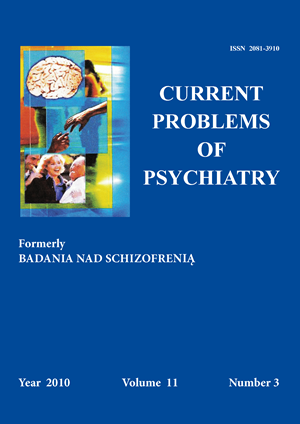Stan padaczkowy - rozpoznanie i leczenie
Słowa kluczowe:
padaczka, stan padaczkowyAbstrakt
Padaczka jest najczęstszym schorzeniem neurologicznym, występującym u 1 na 150 osób, a stan padaczkowy (SP) jest czasem opisywany jako maksymalna ekspresja padaczki i jest związany ze znaczną krótko- i długoterminową śmiertelnością. Istnieje prawie tak dużo typów stanu padaczkowego jak rodzaju napadów padaczkowych. Stan padaczkowy jest unikalnym stanem patologicznym, w którym napady mają tendencję do ciągłego utrzymywania się. Definicja stanu padaczkowego uległa skróceniu z 30 minut w zaleceniach Epilepsy Foundation of America’s Working Group on Status Epilepticus, do 10 minut w VA Cooperative Trial, a ostatnio stosowana jest operacyjna definicja stanu padaczkowego, który można rozpoznać jeśli drgawki trwają powyżej 5 minut. Odzwierciedla to jednocześnie potrzebę znalezienia definicji stanu padaczkowego, która nie spowoduje opóźnienia interwencji terapeutycznej. Powszechnie znane są robocze definicje stanu padaczkowego wczesnego (do 30 minut), utrwalonego (30-60 minut) oraz opornego na leczenie, a podział ten jest wynikiem ewolucji zmian patolofizjologicznych w przebiegu SP. W poniższym artykule przedstawiamy aktualne postępowanie diagnostyczno-terapeutyczne w SP z uwzględnieniem roli nowszych leków przeciwdrgawkowych takich jak lewetiracetam.
Bibliografia
1. Sander J.W. The epidemiology of epilepsy revisited. Curr. Opin. Neurol., 2003; 16: 165-170.
2. Bleck T.P. Convulsive disorders: status epilepticus. Clin. Neuropharmacol., 1991; 14: 191-198.
3. Treiman D.M., Meyers P.D., Walton N.Y., Collins J.F., Colling C., Rowan A.J., Handforth A., Faught E., Calabrese V.P., Uthman B.M., Ramsay R.E., Mamdani M.B. A comparison of four treatments for generalized convulsive status epilepticus. Veterans Affairs Status Epilepticus Cooperative Study Group. N. Engl. J. Med., 1998; 339:792-799.
4. Lowenstein D.H., Bleck T., Macdonald R.L. It's time to revise the definition of status epilepticus. Epilepsia, 1999; 40(1): 120-122.
5. Wasterlain C.G. Mortality and morbidity from serial seizures. An experimental study. Epilepsia, 1974; 15: 155-176.
6. Fujikawa D.G. The temporal evolution of neuronal damage from pilocarpine-induced status epilepticus. Brain Res., 1996; 725: 11-22.
7. Mazarati A.M., Baldwin R.A., Sankar R., Wasterlain C.G. Time-dependent decrease in the effectiveness of antiepileptic drugs during the course of self-sustaining status epilepticus. Brain Res., 1998; 814: 179-85.
8. Kapur J., Macdonald R.L. Rapid seizure-induced reduction of benzodiazepine and Zn2+ sensitivity of hippocampal dentate granule cell GABAA receptors. J. Neurosci., 1997; 17: 7532-7540.
9. Shorvon S.D. Status Epilepticus: its Clinical Features and Treatment in Children and Adults. Cambridge; Cambridge University Press :1994.
10. Treiman D.M., Walton N.Y., Kendrick C. A progressive sequence of electroencephalographic changes during generalized convulsive status epilepticus. Epilepsy Res., 1990; 5: 49-60.
11. DeLorenzo R.J., Waterhouse E.J., Towne A.R., Boggs J.G., Ko D., DeLorenzo G.A., Brown A., Garnett L. Persistent nonconvulsive status epilepticus after the control of convulsive status epilepticus . Epilepsia, 1998; 39: 833-840.
12. Mazarati A.M., Wasterlain C.G. N-methyl-D-asparate receptor antagonists abolish the maintenance phase of self-sustaining status epilepticus in rat. Epilepsia, 1999; 265: 187-190.
13. Walker M.C., Howard R.S., Smith S.J. et al. Diagnosis and treatment of status epilepticus on a neurological intensive care unit. Q. J. Med., 1996; 89: 913-920.
14. Jackson M.J. Choice of antiepileptic drug, which one to try first and what to do if it fails. Practical Neurol., 2005; 5: 6-17.
15. Burneo J.G., Anandan J.V. Barkley G.L. A prospective study of the incidence of the purple glove syndrome. Epilepsia, 2002; 42: 1156-1159.
16. DeToledo J.C. Ramsay R.E. Fosphenytoin and phenytoin in patients with status epilepticus – Improved tolerability versus increased costs. Drug Saf., 2000; 22: 459-66.
17. Touchette D.R. Rhoney D.H. Costminimization analysis of phenytoin and fosphenytoin in the emergency department. Pharmacotherapy, 2000; 20: 908-916.
18. Rosenow F., Arzimanoglou A. Baulac M. Recent developments in treatment of status epilepticus: A review. Epileptic Disord., 2002; 4: S41-S51.
19. Wheless J.W., Vazquez B.R., Kanner A.M., Ramsay R.E., Morton L., Pellock J.M. Rapid infusion with valproate sodium is well tolerated in patients with epilepsy. Neurology, 2004; 63: 1507-1508.
20. Eue S., Grumbt M., Muller M., Schulze A. Two years of experience in the treatment of status epilepticus with intravenous levetiracetam. Epilepsy Behav., 2009; 15: 467-469.
21. Knake S., Gruener J., Hattemer K., Klein K.M., Bauer S., Oertel W.H., Hamer H.M., Rosenow F. Intravenous levetiracetam in the treatment of benzodiazepine refractory status epilepticus. J. Neurol. Neurosurg. Psychiatry, 2008; 79: 588-589.
22. Gamez-Leyva G., Aristin J.L., Fernandez E., Pascual J. Experience with intravenous levetiracetam in status epilepticus. CNS Drugs, 2009; 23: 983-987.
23. Hodges B.M., Mazur J.E. Intravenous valproate in status epilepticus. Ann. Pharmacother., 2001; 35: 1465-1470.
24. Minicucci F., Muscas G., Perucca E., Capovilla G., Vigevano F., Tinuper P. Treatment of status epilepticus in adults: guidelines of the Italian League against Epilepsy. Epilepsia, 2006; 47 Suppl: 9-15.
25. Olsen K.B., Tauboll E., Gjerstad L. Valproate is an effective, well-tolerated drug for treatment of status epilepticus/serial attacks in adults. Acta Neurol. Scand., 2007; 187 suppl.: 51-54.
26. Peters C.N., Pohlmann-Eden B. Intravenous valproate as an innovative therapy in seizure emergency situations including status epilepticus-experience in 102 adult patients. Seizure, 2005; 14: 164-169.
27. White H.S. Animal models of epileptogenesis. Neurology, 2002; 59: S7-S14.
28. Shorvon S.D. Does convulsive status epilepticus (SE) result in cerebral damage or affect the course of epilepsy – the epidemiological and clinical evidence? Prog. Brain Res., 2002; 135: 85-93.
29. Limdi N.A., Shimpi A.V., Faught E., Gomez C.R., Burneo J.G. Efficacy of rapid IV administration of valproic acid for status epilepticus. Neurology, 2005; 64: 353-355.


